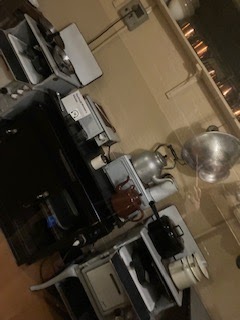Since Dan would be coming out to London for a few days at the semester's end, I kept my eyes open for spots he might enjoy visiting...a man who is hard to please when it comes to vacations (not so much when it comes to foot rubs.) In early March, I and my colleague Danielle visited the Churchill War Rooms just off Parliament Square. My hubby loves history stories, hence one of his favorite bands being Sabaton, and I knew right away he would love this.
During WWII, Winston Churchill and his war cabinet hunkered down in an underground complex called the Cabinet War Rooms. It was supposed to be protected from the Blitz by a 5-meter thick layer of concrete called the "slab." When the war ended, they left the giant bunker just the way it was, and everything that remained was preserved and kept in that space until today. The beds, the phones, the maps...it's all there. They added some mannequins and a quite comprehensive museum area devoted to Churchill which covers the late Prime Minister's life from birth to death.The green phone you see here is a "scrambler" which allowed them to communicate without anyone listening in.
This is Clementine Churchill's room...can you tell?
This is the war room.
This is where the chiefs of staff met.
Here is the broadcast room.
Below see the kitchen...which is always my favorite thing to see in these recreations...not sure why. Maybe it is because the kitchen holds fascination for me as a domestic space which plays an important role in human life (women's especially) but there isn't much in the way of official history devoted to it. Anyway...many of the pots were the original, and everything was shown as it was when Churchill was down there smoking cigars and eating Beef Wellington. They had a dining room, sure enough, and apparently ate pretty well for living in a dark ant farm under five meters of concrete.
Note for teachers: As I said, there is a cost involved, but if you are teaching history of WWII or British history, I'd say this place is a must. I especially appreciated the way it captured the feeling of the time, and in particular the notion of living with the reality of war. In some ways, I can see potential for creative writers, especially with regard to capturing setting. Architectural design and engineering could also get something out of this...the original construction is pretty thought provoking.
If I did assign something for Creative Writing for this, it would be to write a scene taking place in one of these rooms, in which they are to establish the setting economically (place us in that space as the museum tried to do.)








No comments:
Post a Comment